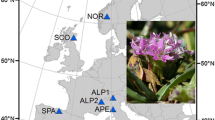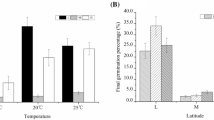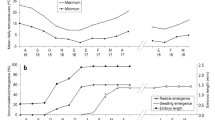Abstract
Increases in populations of the two native higher plants that exist in the Antarctic have been thought to be caused by an improvement in their reproductive performance as a result of regional warming. Colobanthus quitensis dispersion by seeds and establishment are limited to years with sufficiently high summer temperatures. The main objective of this work was to evaluate the effect of increased growth temperature on the germination ability of C. quitensis. Individuals were collected from King George Island and grown at two different thermoperiods: 5/2 and 11/5 °C, day/night. Mature seeds produced under both growth temperatures were tested for viability and incubated under a range of temperatures from 5° to 35 °C. Seed viability was not significantly different between growth temperatures. Germination for C. quitensis was highly temperature dependent. Germination was modulated by temperatures over 10 °C. Seeds from 5/2 °C showed significant higher germination (>80 %) between 10 and 15 °C. Seed developed at 11/5 °C showed a broader range of temperature for germination between 10 and 25 °C. Higher growth temperature (11/5 °C) reduced the germination time significantly. Our results suggest that annual production of seeds leads to a high probability of germination at warmer environmental conditions because dormancy would be reduced at higher temperatures. Therefore, higher environmental temperatures, as those predicted to occur because of global warming, would increase the propagation of C. quitensis by germination.


Similar content being viewed by others
References
Baskin CC, Baskin JM (1998) Seeds: ecology, biogeography, and evolution of dormancy and germination. Academic Press, New York
Bernareggi G, Carbognani M, Petragglia A, Mondoni A (2015) Climate warming could increase seed longevity of alpine snowbed plants. Alp Bot 125:69–78
Billings WD, Mooney HA (1968) The ecology of arctic and alpine plants. Biol Rev 43:481–529
Convey P (1996) The influence of environmental characteristics on the life history attributes of Antarctic terrestrial biota. Biol Rev 71:191–225
Convey P, Smith RIL (2006) Responses of terrestrial Antarctic ecosystems to climate change. Plant Ecol 182:1–10
Corner RWM (1971) Studies in Colobanthus quitensis (Kunth) Bartl. and Deschampsia antarctica Desv. IV: distribution and reproductive performance in the Argentine islands. Br Antarct Surv Bull 26:41–50
Corte A (1961) Fertilidad de las semillas en fanerogamas que crecen en Cabo Primavera (Costa de Danco), Peninsula Antartica. (Seed fertility in phanerogams growing at Spring Cape [Danco Coast, Antarctic Peninsula]). Contrib Inst Antart Argent 65:1–16
Datta SC, Evenari M, Gutterman Y (1972) Photoperiodic and temperature responses of plants derived from the various heteroblastic caryopses of Aegilops ovata L. J Indian Bot Soc 50:546–559
Day TA, Ruhland CT, Grobe CW, Xiong F (1999) Growth and reproduction of Antarctic vascular plants in response to warming and UV radiation reductions in the field. Oecologia 119:24–35
Dove N (2010) The effect of increasing temperature on germination of native plant species in the north woods region. University of Vermont, Thesis
Edwards JA (1972) Studies in Colobanthus quitensis (Kunth) Bartl. and Deschampsia antarctica Desv: V: distribution, ecology and vegetative performance on Signy Island. Br Antarct Surv Bull 28:11–28
Edwards JA (1974) Studies in Colobanthus quitensis (Kunt) Bartl. and Deschampsia Antarctica Desv.: VI: reproductive performance on Signy Island. Br Antarct Surv Bull 39:67–86
Fowbert JA, Smith RI (1994) Rapid population increases in native vascular plants in the Argentine Islands, Antarctic Peninsula. Arct Alp Res 26:290–296
Gielwanowska I, Bochenek A, Gojlo E, Görecki R, Kellmann W, Pastorczyk M, Szczula E (2011) Biology of generative reproduction of Colobanthus quitensis (Kunth) Bartl. from King George Island, South Shetland Islands. Polish Polar Research 32:139–155
Graae BJ, Alsos IG, Ejrnaes R (2008) The impact of temperature regimes on development, dormancy breaking and germination of dwarf shrub seeds from arctic, alpine and boreal sites. Plant Ecol 198:275–284
Greene DM, Holtom A (1971) Studies in Colobanthus quitensis (Kuhnt) Bartl. and Deschampsia antarctica Desv. III: distribution, habitats and performance in the Antarctic botanical zone. Br Antarct Surv Bull 26:1–29
Grobe CW, Ruhland CT, Day TA (1997) A new population of Colobanthus quitensis near Arthur Harbor, Antarctica: correlating recruitment with warmer summer temperatures. Arct Alp Res 29:217–221
Gutterman Y (2000) Maternal effects on seeds during development. In: Fenner M (ed) Seeds: the ecology of regeneration in plant communities, 2nd edn. CABI Publishing, Wallingford, pp 59–84
Holtom A, Greene SW (1967) The growth and reproduction of Antarctic flowering plants. Philos Trans R Soc: Lond, Ser B 252:323–337
Keigley PJ, Mullen RE (1986) Changes in soybean seed quality from high temperatures during seed fill and maturation. Crop Sci 26:1212–1216
Longton RE, Holdgate MW (1967) Temperature relationships of Antarctic vegetation. In: Smith JE (organ.) A discussion on the terrestrial Antarctic ecosystem. Philos Trans R Soc vol 252, pp 323–337
McGraw JB, Day TA (1997) Size and characteristics of a natural seed bank in Antarctic. Arct Alp Res 29:213–216
Milbau A, Graae BJ, Shectsova A, Nijs I (2009) Effects of a warmer climate on seed germination in the subarctic. Ann Bot 104:287–296
Mondoni A, Probert RJ, Rossi G, Vegini E, Hay FR (2011) Seeds of alpine plants are short-lived: implications for long-term conservation. Ann Bot 107:171–179
Müller E, Cooper EJ, Alsos IG (2011) Germinability of Arctic plants is high in perceived optimal conditions but low in the field. Bot Botanique 89:337–348
Nicotra AB, Atkin OK, Bonser SP, Davidson AM, Finnegan EJ, Mathesius U, Poot P, Purugganan MD, Richards CL, Valladares F, van Kleunen M (2010) Plant phenotypic plasticity in a changing climate. Trends Plant Sci 12:684–692
Poljakoff-Mayber A, Corbineau F, Côme D (1990) A possible mechanism of high temperature dormancy regulation in seeds of Avena sativa L. (cv. Moyencourt). Plant Growth Regul 9:147–156
Probert RJ (2000) The role of temperature in the regulation of seed dormancy and germination. In: Fenner M (ed) Seeds: the ecology of regeneration in plant communities. CAB International, Wallingford, pp 261–292
Probert RJ, Smith RD (1986) The joint action of phytochrome and alternating temperatures in the control of seed germination in Dactylis glomerata. Physiol Plant 67:299–304
Reynolds T, Thompson PA (1971) Characterization of the high temperature inhibition of germination of Lettuce (Lactuca sativa). Physiol Plant 24:544–547
Roach DA, Wulff RD (1987) Maternal effects in plants. Annu Rev Ecol Evol Syst 522:209–235
Ruhland CT, Day TA (2001) Size and longevity of seed banks in Antarctica and the influence of ultraviolet-B radiation on survivorship, growth and pigment concentrations of Colobanthus quitensis seedlings. Environ Exp Bot 45:143–154
Smith RIL (1994) Vascular plants as bioindicators of regional warming in the Antarctic. Oecologia 99:322–328
Smith RIL (2003) The enigma of Colobanthus quitensis and Deschampsia antarctica in Antarctica. In: Huiskes AHL, Gieskes WWC, Rozema J, Schorno RML, van der Vies SM, Wolff WJ (eds) Antarctic biology in a global context. Backhuys, Leiden, pp 234–239
Vaughan DG, Marshall GJ, Connolley WM, Parkinson C, Mulvaney R, Hodgson DA, King JC, Pudsey CJ, Turner J (2003) Recent rapid regional climate warming on the Antarctic Peninsula. Clim Change 60:243–274
Walck JL, Hidayati SN, Dixon KW, Thompson K, Poschlod P (2011) Climate change and plant regeneration from seed. Glob Change Biol 17:2145–2161
Zar JH (1999) Biostatistical analysis, 4th edn. Prentice-Hall, Upper Saddle River
Zhang YF, Wang C, Tian SL, Lu JQ (2014) Dispersal and hoarding of sympatric forest seeds by rodents in a temperate forest from northern China. iForest 7:70–74
Acknowledgments
The authors thank Projects CONICYT-PIA ART 1102 and Fondecyt 11130332, for funding our field and laboratory work and Instituto Antártico Chileno (INACH) for logistic support in Antarctica and the necessary permits to enter and collect plants in SPA 128.
Author information
Authors and Affiliations
Corresponding author
Rights and permissions
About this article
Cite this article
Sanhueza, C., Vallejos, V., Cavieres, L.A. et al. Growing temperature affects seed germination of the antarctic plant Colobanthus quitensis (Kunth) Bartl (Caryophyllaceae). Polar Biol 40, 449–455 (2017). https://doi.org/10.1007/s00300-016-1972-4
Received:
Revised:
Accepted:
Published:
Issue Date:
DOI: https://doi.org/10.1007/s00300-016-1972-4




